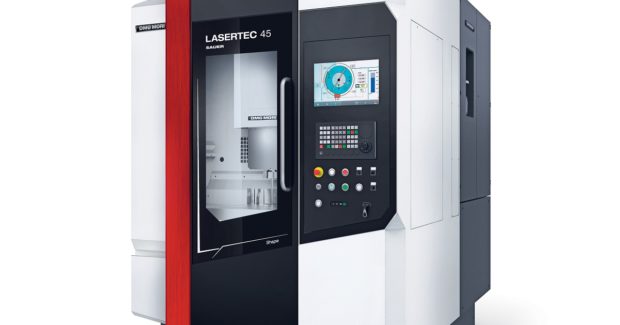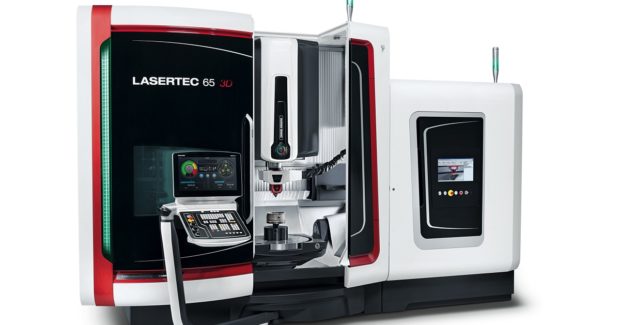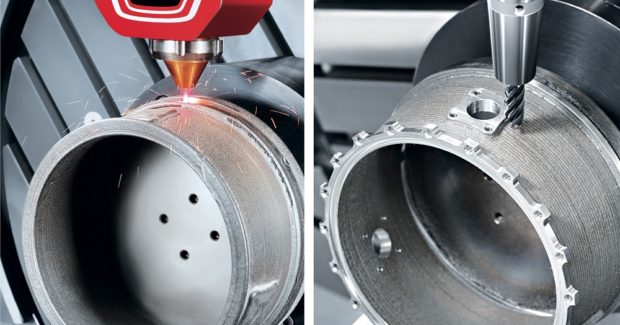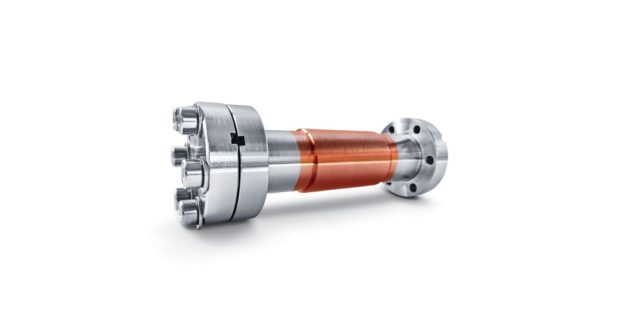The Shape of Hybrid Machining
The SAUER LASERTEC 45 Shape from DMG MORI uses 3D laser ablation to make small integrated parts or achieve defined textures in injection molding tools, and their SAUER LASERTEC 65 3D hybrid machine combines laser deposition welding and 5-axis milling to make highly complex parts in one setup.
Posted: February 24, 2017
The SAUER LASERTEC 45 Shape and the SAUER LASERTEC 65 3D hybrid machines from DMG MORI (Hoffman Estates, IL) combine laser deposition welding and 5-axis milling for the additive manufacturing of complete 3D components in finished part quality. Shape technology uses 3D laser ablation for small integrated parts or to achieve defined textures in injection molding tools. This technology is an extremely reliable and productive way of machining intricate structures and can also have a sustainable impact on the manufacture of injection molding tools. “Machining is carried out directly on the workpiece, so there is no longer any need for the separate machining of electrodes,” explains Friedemann Lell, the head of sales for LASERTEC machines at DMG MORI. “This reduces production times enormously, especially where fine, detailed parts are concerned.”
The fact that there is no wear on the tools also contributes to process reliability and cost effectiveness. “And all this as of a batch size of one, because there are no tool costs and CAD data can be imported directly,” adds Lell. Another application for Shape technology is the structuring of injection molding tools. This allows the texturing of irregular shapes (e.g. leather texturing) or geometric structures (e.g. pyramid structures). Creating geometric structures takes immense time and effort without laser or in some cases cannot be achieved at all. In every specific application, the respective CAD data define the geometric textures to be applied on the component. This gives designers enormous scope where the design of the surfaces is concerned. Actual laser ablation is carried out in horizontal layers with thicknesses of between 0.3 µm and 10 µm, depending on the laser and material. This allows the creation of 3D structures on the workpiece. What is more, these textures can be reproduced as often as desired. “Even small tools can be produced directly with this technology,” notes Lell, referring to other areas of application for this process. “It is also suitable for miniature molds, stamping tools or the lettering and engraving of coins and medals.”
The versatile LASERTEC 45 Shape is just one more example of a great leap forwards in the sector of laser machining. The work area is 80 percent larger on the same size footprint of the previous model. Travel and load capacity have also been significantly increased. There is now also a 5-axis version that has space for components of up to ø12 in x 8 in and weights of 220 lb. The A-axis has a swivel range of -100 deg to +120 deg. But the real technical highlight of this machine is the interaction of precision optics – consisting of a laser head with the latest scanner optics technology and a CCD camera – and the highly dynamic deflection mirrors. The boost in performance goes on to include the dynamics: rapid traverses of 60 m/min are more than three times faster than those of the predecessor machine.
The LASERTEC 65 3D hybrid machine has made an equally great step forward in the additive manufacturing segment. The absolute unique selling point of this system is the combination of laser deposition and milling in a single setup that enables the production of highly complex components. This technology opens up dimensions in construction that would have been unthinkable before, like many 3D geometries with undercuts or, for instance, conformal cooling of injection molding tooling. These cooling passages are made by laser deposition. In many cases this can allow the currently installed base of injection molding equipment to be operated at higher throughput by reducing the required cooling time for each “shot.” The process of laser deposition and milling in a single setup is so cost-effective that it proves invaluable especially where the production of prototypes are concerned, or in the small series production of complex lightweight and integral components. “We also envision applications in tool and mold construction, in aerospace, automotive as well as medical technologies,” states Lell.
The way the LASERTEC 65 3D functions is as simple as it is ingenious: a powder nozzle is used to apply the metal powder – stainless steel or also many different alloys such as tool steel or nickel-based alloys – in layers onto the base material with which it then fuses in the melting point of the laser beam. This is nothing more than a high-strength pore and crack-free fusion bond. An inert gas prevents oxidation during the build-up process. After cooling a layer of metal forms, which can then be machined mechanically. This process also allows bimetallic depositions that can include copper cores to dissipate heat or hard-facing to resist wear. Thanks to the combination of laser deposition and milling on a single machine this process can now be carried out in one and the same setup.
“As both machining processes can be used alternately, many 3D contours can be produced completely without the need of any supporting geometry,” says Lell. “Compared with the conventional powder bed method, laser deposition welding is ten times faster! Whereby currently wall thicknesses of 0.06 in and 0.12 in are produced. And for final milling, the component does not have to be re-clamped somewhere else.” Not only is this more cost-effective, it also ensures much higher machining accuracy. All the advantages of the monoBLOCK® machining system are integrated into the LASERTEC 65 3D. The integration of laser heads from other machines has also been put to good use here, as proven by the automatic shuttle-handling for the changing of the laser head and the HSK 63 interface. “For laser deposition welding we use a completely new laser head with integrated cooling, process monitoring and an integrated camera that controls the process optically and adjusts the laser power online,” explains Lell.
Aiming at a more extended range of applications with larger tools, DMG MORI also offers the LASERTEC 4300 3D that supports larger work envelopes and offers 6-axis deposition, as well as the capability to automatically change between various deposition heads. This allows miniature deposition heads to traverse complex cavities for repair or large deposition heads to lay down ribbons of metal up to 22 lb per hour. “This machine’s initial applications were driven by the ability to deposit multiple alloys in a single build, typically copper and nickel-based alloys for nozzles, thrust chambers, and ignitors for the rocket motors,” says Dr. Greg Hyatt, the vice president and chief technology officer of DMG MORI Advanced Solutions. “Support for deposition of titanium drove applications in aerospace structural applications, and now the ability to deposit dual alloys, including abrasion resistant tungsten carbide or cobalt-chrome, has found drilling applications in the energy market.”
DMG MORI, 2400 Huntington Boulevard, Hoffman Estates, IL 60192, 847-593-5400, Fax: 847-593-5433, www.dmgmori.com.









